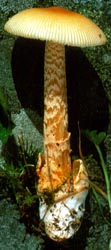|
[ Section Vaginatae page. ] [ Amanita Studies home. ] [ Keys & Checklist/Picturebooks ] Amanita crocea (Quél. in Bourd.) Singer ex Singer"Saffron Ringless Amanita"
Technical description (t.b.d.) BRIEF DESCRIPTION: The cap of Amanita crocea is usually free of volval remnants, 40 - 100 mm wide, umbonate at maturity, with a distinctly striate margin; it is saffron orange (or a little browner than that) in the center when fresh and paler at the margin. The gills are free, close to subcrowded, cream in mass (sometimes with a slight salmon or pinkish reflection, and 2 - 3± mm broad; the short gills are truncate, of varying length, and often infrequent. The stem is 85 - 230 x 7 - 14 mm, exannulate, cream to yellow-cream to pale orange or concolorous with (but paler than) the color near the margin of the cap, with decoration of paler fibrils in a "flame" pattern, with the decoration later becoming orange or brown-orange (darker than the underlying stipe surface), and with a membranous sack-like volva at the base. The external and internal surfaces of the 30 - 65 mm tall volval sack commonly take on orangish cream, pale peach, pale salmon buff, or brownish orange stains; the exterior may also develop rust colored spots; the exterior surface is originally white or whitish. Spot tests with phenol on the stem of this species produce a "rouge fuschine" rather than the usual brown or chocolate brown seen in amanitas. The reaction to syringaldazine spot testing for laccase on a cross-section of a specimen produces two positive dots at the very base of the stem (more ruby than the magenta or lavender usual in amanitas containing laccase -- such as shown in a photograph of A. subsolitaria (Murrill) Murrill) of section Lepidella. The spores measure (8.0-) 9.4 - 11.8 (-18.8) x (7.5-) 8.5 - 11.0 (-16.0) µm and are globose to subglobose (infrequently broadly ellipsoid) and inamyloid. Clamps are not present at bases of basidia. Amanita crocea is widely distributed in Europe in association with aspen, larch, pine, spruce, or birch. While this species' name is applied to collections made in the Americas, no such collection examined by me has ever proven to be the European species. There are at least two New World taxon (still to be described) to which the European name has been incorrectly applied. A short key-fragment is available that may be useful in distinguishing A. crocea, A. flavescens (E. J. Gilbert & S. Lund.) Contu, A. romagnesiana Tulloss, and A. subnudipes (Romagn.) Tulloss as well as the species most phenetically similar to A. fulva (Schaeff.) Fr. Not included in that key is A. ochraceopallida Contu (known from Italy), which is very similar to A. flavescens. -- R. E. Tulloss Photo: R. E. Tulloss (Highlands and Islands Region, Scotland) [ Section Vaginatae page. ] [ Amanita Studies home. ] [ Keys & Checklist/Picturebooks ] Last changed 1 October 2009. |
